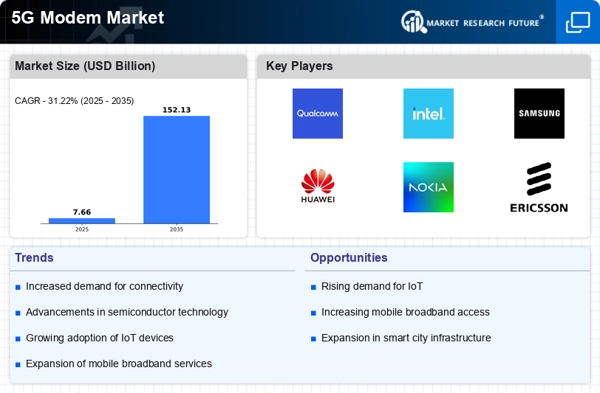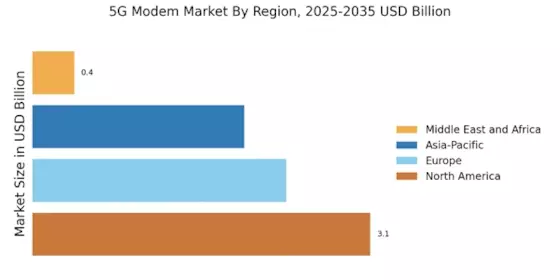The 5G Modem Market is currently characterized by intense competition and rapid technological advancements, driven by the increasing demand for high-speed connectivity and the proliferation of IoT devices. Major players such as Qualcomm (US), Intel (US), and Huawei (CN) are strategically positioned to leverage their technological expertise and extensive R&D capabilities. Qualcomm (US) focuses on innovation in modem technology, particularly in enhancing the performance and efficiency of its 5G chipsets. Meanwhile, Intel (US) is concentrating on expanding its portfolio through strategic partnerships and investments in next-generation networking technologies. Huawei (CN), despite facing geopolitical challenges, continues to invest heavily in R&D, aiming to solidify its position in emerging markets. Collectively, these strategies contribute to a competitive landscape that is both dynamic and multifaceted, with companies vying for leadership through innovation and strategic collaborations.
Key business tactics within the 5G Modem Market include localizing manufacturing and optimizing supply chains to enhance operational efficiency. The market structure appears moderately fragmented, with several key players holding substantial market shares while also facing competition from emerging firms. This fragmentation allows for a diverse range of products and services, catering to various customer needs. The collective influence of these key players shapes market dynamics, as they engage in continuous innovation and strategic maneuvers to maintain their competitive edge.
In August 2025, Qualcomm (US) announced a partnership with a leading telecommunications provider to develop advanced 5G modem solutions tailored for smart cities. This collaboration is strategically significant as it positions Qualcomm at the forefront of the smart city initiative, potentially expanding its market reach and enhancing its reputation as a leader in 5G technology. The partnership underscores the importance of aligning technological advancements with urban development needs, thereby fostering a sustainable ecosystem.
In September 2025, Intel (US) unveiled its latest 5G modem, which integrates AI capabilities to optimize network performance. This launch is crucial as it reflects Intel's commitment to innovation and its strategy to differentiate its offerings in a competitive market. By incorporating AI, Intel aims to enhance user experience and operational efficiency, which could lead to increased adoption of its products in various sectors, including automotive and industrial applications.
In July 2025, Huawei (CN) secured a significant contract to supply 5G modems for a national telecommunications project in Southeast Asia. This development is indicative of Huawei's resilience and ability to navigate geopolitical challenges while expanding its footprint in emerging markets. The contract not only reinforces Huawei's market position but also highlights the growing demand for 5G infrastructure in developing regions, where connectivity is becoming increasingly vital for economic growth.
As of October 2025, current competitive trends in the 5G Modem Market are heavily influenced by digitalization, sustainability, and the integration of AI technologies. Strategic alliances are increasingly shaping the landscape, as companies recognize the need for collaboration to drive innovation and address complex market demands. Looking ahead, competitive differentiation is likely to evolve from traditional price-based competition to a focus on technological innovation, supply chain reliability, and sustainable practices. This shift may redefine how companies position themselves in the market, emphasizing the importance of adaptability and forward-thinking strategies.


















Leave a Comment